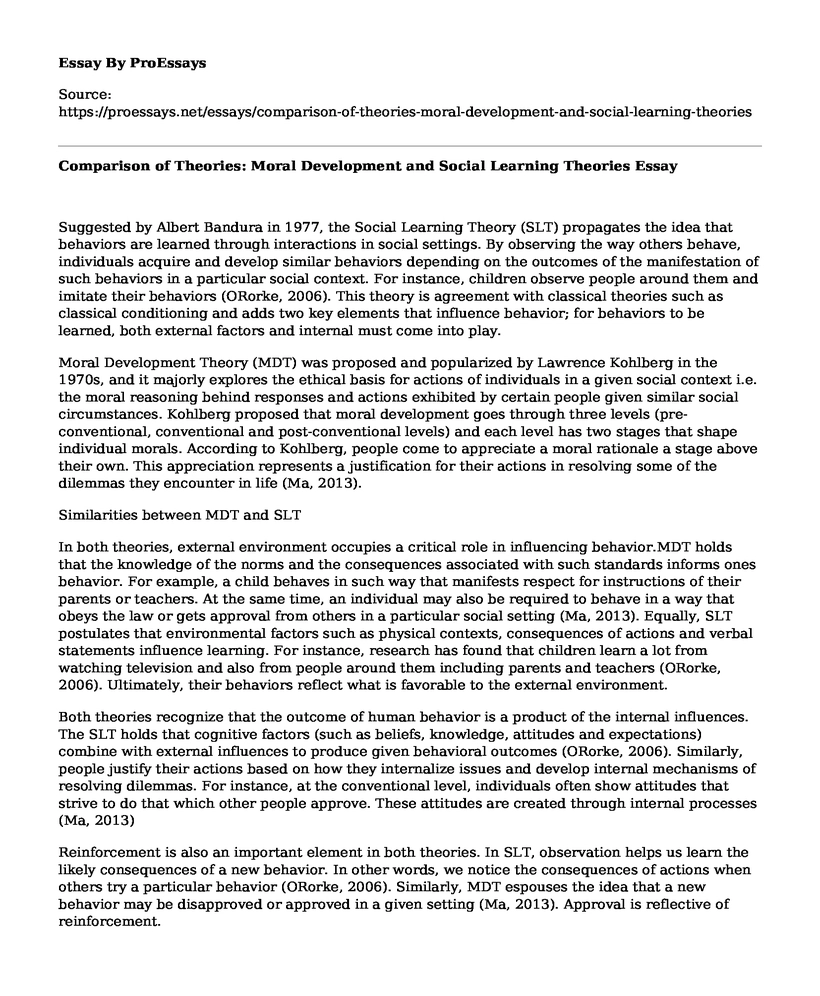Suggested by Albert Bandura in 1977, the Social Learning Theory (SLT) propagates the idea that behaviors are learned through interactions in social settings. By observing the way others behave, individuals acquire and develop similar behaviors depending on the outcomes of the manifestation of such behaviors in a particular social context. For instance, children observe people around them and imitate their behaviors (ORorke, 2006). This theory is agreement with classical theories such as classical conditioning and adds two key elements that influence behavior; for behaviors to be learned, both external factors and internal must come into play.
Moral Development Theory (MDT) was proposed and popularized by Lawrence Kohlberg in the 1970s, and it majorly explores the ethical basis for actions of individuals in a given social context i.e. the moral reasoning behind responses and actions exhibited by certain people given similar social circumstances. Kohlberg proposed that moral development goes through three levels (pre-conventional, conventional and post-conventional levels) and each level has two stages that shape individual morals. According to Kohlberg, people come to appreciate a moral rationale a stage above their own. This appreciation represents a justification for their actions in resolving some of the dilemmas they encounter in life (Ma, 2013).
Similarities between MDT and SLT
In both theories, external environment occupies a critical role in influencing behavior.MDT holds that the knowledge of the norms and the consequences associated with such standards informs ones behavior. For example, a child behaves in such way that manifests respect for instructions of their parents or teachers. At the same time, an individual may also be required to behave in a way that obeys the law or gets approval from others in a particular social setting (Ma, 2013). Equally, SLT postulates that environmental factors such as physical contexts, consequences of actions and verbal statements influence learning. For instance, research has found that children learn a lot from watching television and also from people around them including parents and teachers (ORorke, 2006). Ultimately, their behaviors reflect what is favorable to the external environment.
Both theories recognize that the outcome of human behavior is a product of the internal influences. The SLT holds that cognitive factors (such as beliefs, knowledge, attitudes and expectations) combine with external influences to produce given behavioral outcomes (ORorke, 2006). Similarly, people justify their actions based on how they internalize issues and develop internal mechanisms of resolving dilemmas. For instance, at the conventional level, individuals often show attitudes that strive to do that which other people approve. These attitudes are created through internal processes (Ma, 2013)
Reinforcement is also an important element in both theories. In SLT, observation helps us learn the likely consequences of a new behavior. In other words, we notice the consequences of actions when others try a particular behavior (ORorke, 2006). Similarly, MDT espouses the idea that a new behavior may be disapproved or approved in a given setting (Ma, 2013). Approval is reflective of reinforcement.
Differences
The MDT is concerned with what is ethical behavior in a given social setting; what is right or wrong and what is good or bad. As such, moral reasoning is influenced by social factors such as parents, the law, and social construction, among others (Ma, 2013). On the other hand, SLT theory delves into the learning of both ethical and ethical behaviors either by observation or through symbolic models (ORorke, 2006).
Once behaviors have been acquired in SLT, they do not undergo modification in a sequential process. For instance, through instructions of teachers, people know how to drive and, therefore, avoid consequences of learning on their own. After the acquisition of the driving knowledge and skills, such acquisitions are reflected throughout ones driving lifetime (ORorke, 2006).Conversely, in MDT, learning process goes through six stages during which morals are modified to reflect what constitutes morality in certain social contexts (Ma, 2013).
References
Ma, H. K. (2013). The Moral Development of the Child: An Integrated Model. Frontiers in Public Health, 1. doi:10.3389/fpubh.2013.00057
ORorke, K. (2006). Social learning theory & mass communication. ABEA Journal, 25(2), 72-74.
Cite this page
Comparison of Theories: Moral Development and Social Learning Theories. (2021, Jun 15). Retrieved from https://proessays.net/essays/comparison-of-theories-moral-development-and-social-learning-theories
If you are the original author of this essay and no longer wish to have it published on the ProEssays website, please click below to request its removal:
- Maladaptive Behavior Case Study
- Research Paper on Mental Health and Physical Activity
- Matt's Turning Point in Life Essay Example
- Research Paper on Event/Theory Impact to the Field Theory of ASD
- Paper on Why Mandatory School Uniforms Are Far Better than Free Choice
- Paper Sample on Gaining Economic Empowerment: Benefits & Impact on Community
- Report Example on Abnormal Psychology







